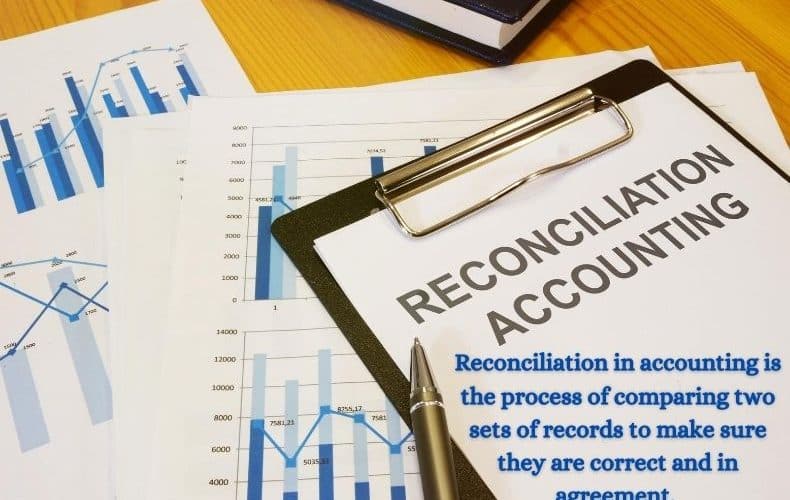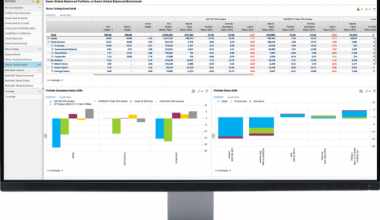Reconciliation is an accounting process in which two sets of records are compared to ensure that the results are correct and consistent. It also ensures that the general ledger accounts are consistent, correct, and complete. In addition to business, reconciliation can be employed for personal reasons. We’ll go over the meaning, examples, and procedure of bank reconciliation accounting in this article.
Account reconciliation is particularly beneficial for explaining differences in financial data or account balances. Because of the timing of payments and deposits, some flaws may be allowed. Unexplained or puzzling differences, on the other hand, could indicate fraud or accounting fraud. Individuals and businesses can reconcile their records on a daily, monthly, or annual basis.
Meaning Reconciliation Accounting
Reconciliation Accounting could be a method of ensuring that the balance in a checkbook corresponds to the matching bank statement. A bank reconciliation statement is typically used to accomplish this. Or
A method of checking the accuracy of a company’s accounting records by comparing [balances of transactions] on a regular basis. A daily, monthly, or annual account reconciliation can be completed.
The generally accepted accounting principles (GAAP) are a collection of accounting rules, procedures, and standards that businesses follow while preparing financial statements. The goal of account reconciliation, according to GAAP, is to ensure that financial accounts are accurate and consistent. Reconciliation accounts are to guarantee that all cash outlays and inflows match between cash flow statements and income statements.
Reconciliation is a technique that can assist firms to avoid balance sheet errors that could have had negative consequences; in addition, reconciliation can assist prevent fraud and establish financial integrity.
Accounting software is one of a variety of tools that businesses employ to automate this process, reducing errors and allowing them to make precise decisions based on financial data. Account reconciliation examines whether transactions are in the correct account or should they move them to another.
Accounting reconciliation is vital for corporations, but it can also be useful for families and individuals. Credit card accounts and checkbooks, for example, should be reconciled on a regular basis. You can achieve this by comparing a person’s bank statements to debit card receipts or check copies.
Advantages of reconciling are as follows:
#1. If there have been any fraudulent withdrawals from an account, it mitigates any mistakes made by financial institutions.
#2. It assists in forming an overall picture of expenditures and determining whether a person is overspending on fees.
#3. In the financial reporting process, account reconciliation is a critical internal control. These actions must be complete as part of a public company’s financial closing.
What Is an Example Reconciliation?
A comparison between a bank statement and an internal record of cash inflows and expenditures. Comparing a statement of accounts receivable to a customer’s record of unpaid bills. Comparing a supplier’s invoice to the company’s list of unpaid invoices.
What Are the 3 Types of Reconciliation?
There are five main different types of account reconciliation: bank reconciliation, reconciliation with vendors, reconciliation with other businesses, reconciliation between companies, and reconciliation with customers.
Bank Reconciliation
A bank reconciliation statement reconciles an entity’s bank account with its financial records by summarizing banking and commercial activity. The statement details the deposits, withdrawals, and other transactions that have occurred in a bank account over a given time period. A bank reconciliation statement is also a valuable financial internal control tool for detecting and preventing fraud.
Payments have been processed, and cash collections have been put into the bank, according to bank reconciliation data. The reconciliation statement aids in identifying differences between the bank and book balances so that appropriate changes or repairs can be made. Once a month, an accountant processes reconciliation statements.
A reconciliation statement must account for all costs levied by a bank on an account.
The balance on a bank reconciliation account should equal the bank account’s ending balance after all adjustments.
Procedure for Bank Reconciliation
Step 1; To discover uncleared checks and deposits in transit, compare the company’s list of issued checks and deposits to the checks reflected on the bank statement.
Step 2; Add back any deposits in transit using the cash balance stated on the bank statement.
Step 3; Subtract any unpaid checks. The altered bank cash balance will be displayed as a result of this.
Step 4; Then, add any interest earned and the number of notes receivable to the company’s ending cash balance.
Step 5; Subtract any bank fees, fines, or NSF checks. As a result, the company’s cash balance will be altered.
Step 6; The adjusted bank balance should equal the company’s ending adjusted cash balance after reconciliation.
As an illustration
A Band Company is closing its records, and the following items must be reconciled at the bank:
On Jan 29, 2020, the bank statement indicates an ending balance of $500,000, however, the company’s ledger indicates an ending balance of $460,900. A $150 service charge for operating the account appears on the bank statement. The bank statement also shows an income interest of $25.
The company issued $50,000 checks that have yet to be cleared by the bank. Also made a deposit of $20,000, however, it did not show up on the bank statement.
In the cash payments log, a check for $500 issued to the official supplier was misreported as $460.
The bank was able to recover a $10,400 note receivable. A cheque for $520 that was deposited by the corporation was returned as NSF.
Ways to Reconciling an Account
The major methods for reconciling an account are as follows:
#1. Examine the documentation
The most typical method of account reconciliation is documentation review. It entails retrieving account information from the statements and assessing the suitability of each transaction. The documentation technique determines whether the amount recorded in the account corresponds to the amount actually spent by the company.
For example, a business keeps track of all receipts for purchases to ensure that the money spent is going to the appropriate places. During a month-end reconciliation, the accountant finds out that the company has been paying ten times for a transaction that was not in the cash book. To learn more about the mysterious transaction, the accountant phoned the bank.
Whereby the strange transaction was determined to be a bank error, the bank repaid the company for the improper deductions. The bank statement balance and the cash book balance are reconciled once the bank inaccuracies are corrected.
#2. Analytical evaluation
You can reconcile accounts using estimations of historical account activity levels in the analytics review approach. It entails predicting the real amount that should be in the account based on account activity levels or other data in the past. The method is used to determine if the disparity is the result of a balance sheet error or theft.
For instance, a corporation can estimate the amount of predicted bad debts in the receivables account to check if it’s near to the allowance for dubious accounts balance. The projected bad debts are calculated using the bad debts allowance’s previous activity levels.
Reconciliation Accounting Example
The purchase of specific assets for a business that generates revenue and ensuring that the acquisition reflects properly on both the balance sheet and the income statement is an example of reconciliation accounting. The cash used to make the purchases would be credited to the asset account and debited from the cash account.
A reconciliation entails comparing two sets of records to see whether any discrepancies exist. Reconciliations are an important step in assuring the accuracy of accounting data. The following are some examples of reconciliations accounting:
#1. Comparing a bank statement to an internal cash receipts and disbursements record.
#2. Compare a receivable statement to a customer’s outstanding bills record.
#3. Compare a supplier statement to a company’s outstanding bill record.
Make sure you thoroughly go through the reconciliation accounting examples to avoid errors on both the balance sheet and the income statement.
Reconciliation Accounting Process
Most businesses make use of accounting software to record transactions and reconcile any differences between the bank statement and the cash book. Reconciliation, on the other hand, may necessitate human intervention to record transactions that were recorded mistakenly, omitted, or were the result of bank errors. The following is a step-by-step guide to performing an account reconciliation process:
#1. Compare the bank statement to the cash book statement.
Cross-reference all transactions in the cash book with similar transactions in the bank statement. Make a list of any transactions in the bank statement that are unsupported, that is, transactions that are not backed up by proof such as a payment receipt. This is the first process to any account reconciliation.
#2. Make a list of all payments made in the cash book that does not reflect on the bank account statement as payments.
Checks and ATM transactions are examples of possible transactions. So, subtract the transactions from the balance on the bank statement. Transactions that show on the bank statement but do not appear in the cash book should also be noted. ATM service costs and check printing fees are examples of transactions that may be impacted. overdrafts, unpaid checks, and so on.
#3. Look for transactions that appear in both the cash book and the bank statement.
Find and add to the bank statement balance any direct deposits and account credits that appear in the cash book but not on the bank statement. Similarly, if deposits appear on the bank statement but not in the cash book, add the entries to the balance in the cash book
#4. Double-check the bank statement for any discrepancies.
A bank error occurs when a check or deposit is debited or credited to the wrong account on a bank statement. Although bank errors are uncommon, the organization should contact the bank as soon as possible to report the problems. The fix will appear in a future bank statement, but to reconcile the mistake, an adjustment to the current period’s bank reconciliation is important.
#5. Double-check that the balances are equal.
The balances in both records should be equal after discovering proof for all variances between the bank statement and the cash book. A bank reconciliation statement should prepare to explain the discrepancy between the company’s internal records and the bank account.
Frequently Asked Questions
Who prepare bank reconciliation statement?
Because transactions may still be occurring on the actual statement date, an accountant normally creates the bank reconciliation statement utilizing all transactions from the previous day. A reconciliation statement must include all deposits as well as withdrawals made to an account.
How is Bank Reconciliation calculated?
A bank reconciliation is similar to a formula. (Cash account balance according to your records) plus or minus (reconciling items) = (Bank statement balance). Your bank reconciliation is complete once this formula is balanced.
What are the types of reconciliation?
Bank reconciliation, customer reconciliation, vendor reconciliation, intercompany reconciliation, and business-specific reconciliation are the five basic types of account reconciliation.






